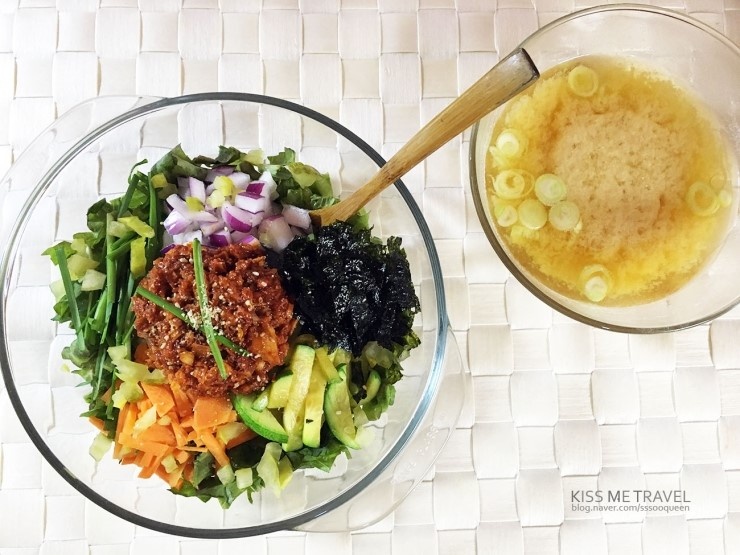Simple Salmon Bibimbap
On Days You Don’t Want to Go Near the Stove: ‘Salmon Bibimbap’!

On hot days like these, your appetite might dwindle, and the thought of standing in front of a hot stove can be daunting. That’s why I’m sharing this ‘Salmon Bibimbap’ recipe, perfect for such times! You can also use canned tuna if you prefer. This dish is a refreshing and easy way to enjoy a satisfying meal without much cooking.
Ingredients- 1 can salmon (drained)
- 2 bowls of rice
- 1/4 onion
- 1/5 carrot
- 1/5 green onion
- 1/5 zucchini
- A little bit of chives
- A little bit of pickle relish (optional)
Seasoning Sauce- 1 Tbsp gochujang (Korean chili paste)
- 1 tsp gochugaru (Korean chili flakes)
- 1 tsp soy sauce
- 1 tsp maesilcheong (plum extract, or substitute with sugar/oligosaccharide)
- 1 tsp vinegar
- 1 tsp minced garlic
- 1 tsp sesame oil
- A little bit of shredded seaweed (gim)
- 1 Tbsp gochujang (Korean chili paste)
- 1 tsp gochugaru (Korean chili flakes)
- 1 tsp soy sauce
- 1 tsp maesilcheong (plum extract, or substitute with sugar/oligosaccharide)
- 1 tsp vinegar
- 1 tsp minced garlic
- 1 tsp sesame oil
- A little bit of shredded seaweed (gim)
Cooking Instructions
Step 1
First, prepare all the ingredients for your bibimbap. It’s a great opportunity to use up any leftover vegetables you have in your fridge, making the dish even more vibrant and flavorful. Leafy greens like lettuce also pair wonderfully with this dish.

Step 2
Drain the oil completely from the canned salmon. Wash all your vegetables thoroughly under running water. Then, chop them into bite-sized pieces that are easy to eat and look appealing in the bibimbap.

Step 3
To mellow out the sharpness of the onion, soak the sliced onion in cold water for about 5 minutes. This step removes some of its pungent bite, making it more pleasant to eat raw.

Step 4
If you have some sweet and sour pickle relish on hand, finely chop it and add it to your bibimbap. The tanginess from the pickles can enhance the overall flavor profile. However, this is entirely optional and can be omitted if you don’t have it or prefer not to use it.

Step 5
Place the zucchini slices in a dry pan without any oil. Sauté over medium-low heat just until the zucchini softens slightly. Cooking it briefly like this helps maintain a pleasant, slightly crisp texture.

Step 6
In a bowl, place the drained salmon. Add all the seasoning sauce ingredients: 1 Tbsp gochujang, 1 tsp gochugaru, 1 tsp soy sauce, 1 tsp maesilcheong, 1 tsp vinegar, and 1 tsp minced garlic. Gently mix everything together with the salmon, being careful not to break up the salmon too much. This creates your flavorful salmon mixture.

Step 7
Now, prepare your serving bowl. Place one bowl of warm rice at the bottom.

Step 8
Drizzle 1 tsp of sesame oil over the rice. The nutty aroma of the sesame oil will seep into the rice grains, enriching the overall flavor of your bibimbap.

Step 9
Finally, artfully arrange the prepared vegetables and the seasoned salmon mixture on top of the rice. Your delicious Salmon Bibimbap is ready to be mixed and enjoyed!




